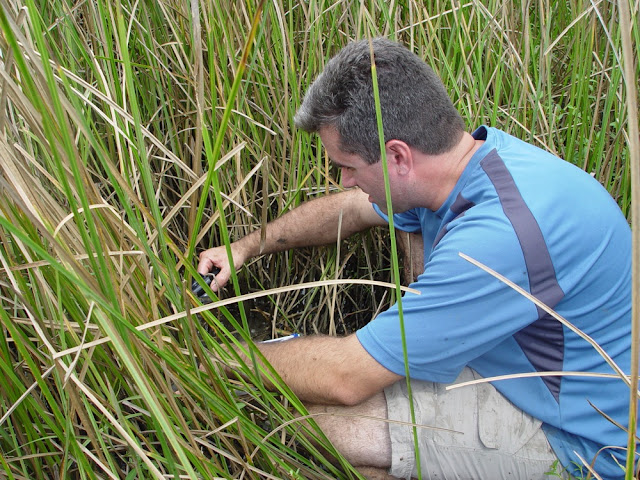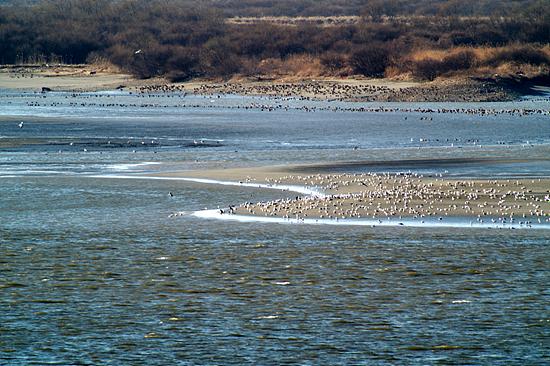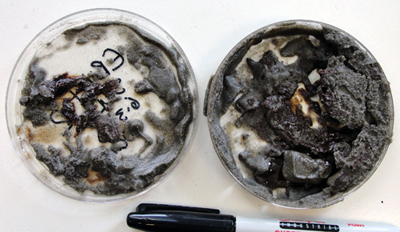The Kostka Lab has several new publications that have come out in the first part of 2009:
Identification of phytodetritus-degrading microbial communities in sublittoral Gulf of Mexico sands.

In the first paper, published in Limnology & Oceanography from Dr. Tom Gihring's Ph.D. research, microbial taxa that catalyze phytodetritus degradation and denitrification in permeable coastal sediments were identified in the northeast Gulf of Mexico. In this study, stable isotope probing experiments were used to track the assimilation of isotopically labeled substrate into bacterial deoxyribonucleic acid (DNA) and directly link the taxonomic identification of benthic microorganisms with particulate organic matter degradation and denitrification activity. This study provides the first identification of microorganisms responsible for organic matter degradation in marine sediments by DNA sequence analysis. Microbial assemblages recognized for high-molecular-weight organic matter oxidation in the marine water column were important in catalyzing these processes in permeable sediments.
Photo: Dr. Thomas Gihring in the Apalachicola Salt Marsh.Denitrification in shallow, sublittoral Gulf of Mexico permeable sediments.
In the second paper, published in Limnology & Oceanography from Dr. Tom Gihring's Ph.D. research, we examined nitrogen cycling over a one-year period in shallow sandy sediments at two contrasting sites near a barrier island in the northeastern Gulf of Mexico and provide the first direct determinations of N2 production at ambient nitrate concentrations in permeable marine sediments. Nitrogen stable isotope tracer techniques were used to quantify N2 production rates and pathways in sediment cores and slurries. To simulate pore-water advection, the dominant transport process in the upper layer of the permeable sand beds, intact sediment cores were perfused with aerated seawater. This perfusion increased denitrification rates up to 2.5-fold in Apalachicola Bay sands and 15-fold in Gulf of Mexico sublittoral sands, respectively, relative to static cores. Seasonal N2 production rates were highest in spring and fall. Denitrified nitrate originated almost entirely from benthic nitrification at the exposed Gulf site, whereas water column nitrate dominated sedimentary denitrification at the sheltered Bay site. Sediment incubations in stirred chambers were used to determine net fluxes of O2, N2, nitrate, and ammonium across the sediment-water interface during varied degrees of continuous pore-water exchange. Rates of N2 efflux correlated with rates of pore-water flow increasing from 0.12 mmol N m-2 d-1 under diffusion-limited transport conditions up to 0.87 mmol N m-2 d-1 with pore water advection. Mineralized nitrogen was completely converted to N2 gas in Gulf of Mexico sediments. Our results demonstrate the role of coastal permeable sediments as important sites for nitrogen removal, and the influence of pore-water flow on denitrification and N2 flux.
Rapid organic matter mineralization coupled to iron cycling in intertidal mud flats of the Han River estuary, Yellow Sea.

This new paper, published in the journal Biogeochemistry, reports on a collaborative study conducted with Jung-Ho Hyun, a professor at Hanyang University in Korea and longtime collaborator with the Kostka lab. The study examines the rates and pathways of anaerobic carbon (C) oxidation in an unvegetated mud flat (UMF) and a vegetated mud flat (VMF) of the Ganghwa intertidal zone of the macro-tidal Han River estuary, South Korea. This study found high rates of C mineralization, suggesting that the primarily open and unvegetated Ganghwa intertidal mud flats are a significant sink against the external loading of organic compounds, and that organic matter mineralization is enhanced by chemical exchange regulated by extreme tidal flushing and macro-microorganisms interactions.
Photo: The Han River Estuary, Yellow Sea. Credit: http://wliasia2008.org.
Identification of sulfate-reducing bacteria in methylmercury contaminated mine tailings by analysis of SSU ribosomal RNA genes.

This paper, published in the journal FEMS Microbiology Ecology, characterizes the bacterial communities of two geochemically contrasting, high-methylmercury mine tailing environments, with emphasis on sulfate reducing bacteria, by analyzing small subunit (SSU) rRNA genes present in the tailings sediments and in enrichment cultures inoculated with tailings. The results of this study provide new insights into the novelty and diversity of bacteria colonizing mine tailings, and identifies specific organisms that warrant further investigation with regard to their roles in mercury methylation and sulfur cycling in these environments.
Photo: Mine tailings from a gold mine in Nova Scotia. Source: www.nrcan.gc.ca.
Citations:T.M. Gihring, M. Humphrys, H.J. Mills, M. Huettel, J.E. Kostka. 2009 Identification of phytodetritus-degrading microbial communities in sublittoral Gulf of Mexico sands. Limnol. Oceanogr., 54: 1073–1083.
ArticleT. M. Gihring, A. Canion, A. Riggs, M. Huettel, and J. E. Kostka. 2009. Denitrification in shallow, sublittoral Gulf of Mexico permeable sediments. Limnology and Oceanography (in press).
J.-H. Hyun, J. S. Mok, H. Y. Cho, S. H. Kim, J. E. Kostka. 2009 Rapid organic matter mineralization coupled to iron cycling in intertidal mud flats of the Han River estuary, Yellow Sea. Biogeochemistry 92: 231–224.
ArticleS. Winch, H. J. Mills, J. E. Kostka, D. Fortin, D. R.S. Lean.
2009 Identification of sulfate-reducing bacteria in methylmercury contaminated mine tailings by analysis of SSU ribosomal RNA genes. FEMS Microbiol. Ecol. FEMS Microbiol Ecol 68: 94–107.
Article


 Samples provided to professors Kostka and Huettel that consist of heavily oiled sediments from a barrier island off the coast of Louisiana. (Photo courtesy of Joel E. Kostka)
Samples provided to professors Kostka and Huettel that consist of heavily oiled sediments from a barrier island off the coast of Louisiana. (Photo courtesy of Joel E. Kostka)


